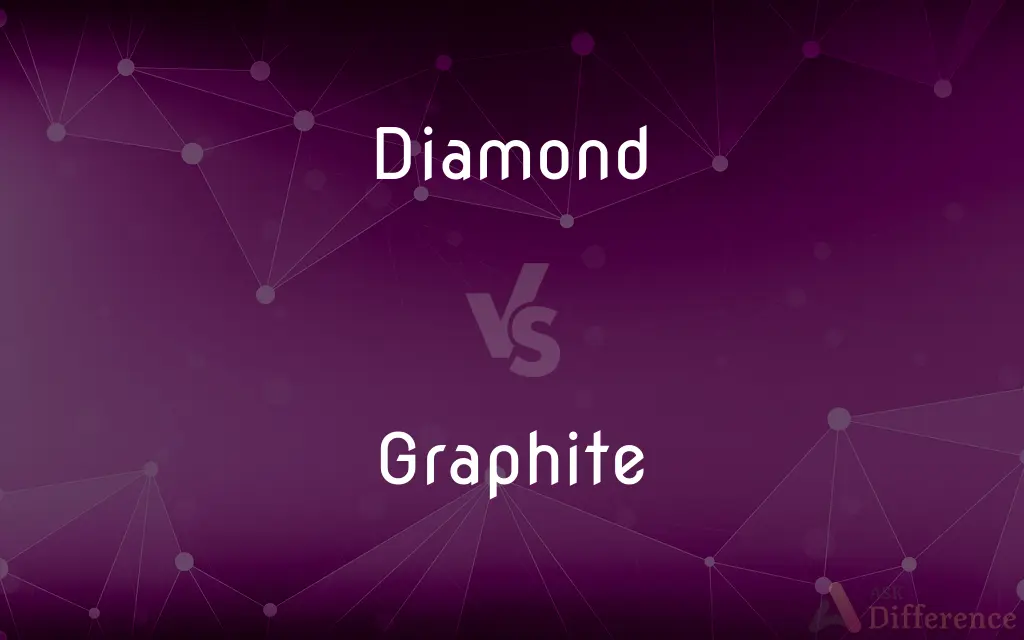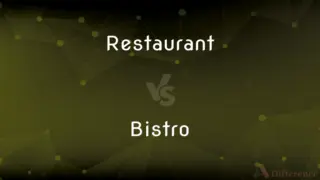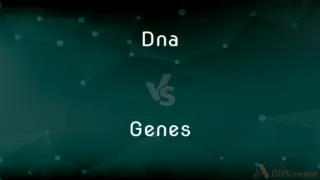Diamond vs. Graphite — What's the Difference?
By Tayyaba Rehman — Updated on October 30, 2023
Diamond is a transparent, hard gemstone; Graphite is a gray, soft form of carbon. Both are carbon allotropes but differ in structure and properties.

Difference Between Diamond and Graphite
Table of Contents
ADVERTISEMENT
Key Differences
A Diamond is a naturally occurring crystalline form of carbon, known for its brilliance and hardness. Graphite, in contrast, is another form of carbon that is soft and slippery.
In terms of atomic structure, Diamond has each carbon atom bonded to four other carbon atoms in a tetrahedral arrangement. In Graphite, each carbon atom is bonded to three others in flat, two-dimensional planes.
The physical properties of Diamond and Graphite greatly vary. While Diamond is renowned for being the hardest natural substance, Graphite is so soft it's used in pencils to write.
Optically, Diamond is usually transparent and can refract light, giving it its characteristic sparkle. Graphite, however, is opaque and has a metallic luster.
While Diamond is typically utilized in jewelry and cutting tools due to its hardness and aesthetic appeal, Graphite has industrial uses, including as a lubricant and in batteries.
ADVERTISEMENT
Comparison Chart
Atomic Bonding
Tetrahedral bonding with 4 other carbon atoms
Planar bonding with 3 other carbon atoms
Hardness
Hardest known natural material
Soft and slippery
Appearance
Transparent and brilliant
Gray, opaque, with a metallic luster
Conductivity
Generally a poor conductor of electricity
Good conductor of electricity
Typical Use
Jewelry and cutting tools
Pencils, lubricants, and batteries
Compare with Definitions
Diamond
A precious gemstone used in jewelry.
He proposed to her with a diamond ring.
Graphite
A form of carbon used for writing and drawing.
The pencil's core is made of graphite.
Diamond
Diamond is a form of the element carbon with its atoms arranged in a crystal structure called diamond cubic. At room temperature and pressure, another solid form of carbon known as graphite is the chemically stable form of carbon, but diamond almost never converts to it.
Graphite
A naturally occurring mineral.
The region is known for its graphite mines.
Diamond
A precious stone consisting of a clear and colourless crystalline form of pure carbon, the hardest naturally occurring substance
A diamond ring
Graphite
An opaque gray substance with a metallic luster.
The graphite sheen gave the rock a distinctive appearance.
Diamond
A figure with four straight sides of equal length forming two opposite acute angles and two opposite obtuse angles; a rhombus
A sweater with a pale-blue diamond pattern
Graphite
A good conductor of electricity.
Graphite electrodes are used in electric arc furnaces.
Diamond
An extremely hard, highly refractive crystalline form of carbon that is usually colorless and is used as a gemstone and in abrasives, cutting tools, and other applications.
Graphite
A lubricant due to its slippery nature.
Graphite powder can be used to lubricate locks.
Diamond
A piece of jewelry containing such a gemstone.
Graphite
Graphite (), archaically referred to as plumbago, is a crystalline form of the element carbon with its atoms arranged in a hexagonal structure. It occurs naturally in this form and is the most stable form of carbon under standard conditions.
Diamond
A rhombus, particularly when oriented so that one diagonal extends from left to right and the other diagonal extends from top to bottom.
Graphite
A soft crystalline allotrope of carbon, composed of graphene layers, having a steel-gray to black metallic luster and a greasy feel, used in lead pencils, lubricants, paints and coatings, and fabricated into a variety of forms such as molds, bricks, electrodes, crucibles, and rocket nozzles. Also called black lead, plumbago.
Diamond
A red, lozenge-shaped figure on certain playing cards.
Graphite
An allotrope of carbon, consisting of planes of carbon atoms arranged in hexagonal arrays with the planes stacked loosely, that is used as a dry lubricant, in "lead" pencils, and as a moderator in some nuclear reactors.
Diamond
A playing card with this figure.
Graphite
Short for graphite-reinforced plastic, a composite plastic made with graphite fibers noted for light weight strength and stiffness.
Modern tennis racquets are made of graphite, fibreglass and other man-made materials.
Diamond
Diamonds (used with a sing. or pl. verb) The suit of cards represented by this figure.
Graphite
A grey colour, resembling graphite or the marks made with a graphite pencil.
Diamond
The infield.
Graphite
(transitive) To apply graphite to.
Diamond
The whole playing field.
Graphite
Native carbon in hexagonal crystals, also foliated or granular massive, of black color and metallic luster, and so soft as to leave a trace on paper. It is used for pencils (improperly called lead pencils), for crucibles, and as a lubricator, etc. Often called plumbago or black lead.
Diamond
Of or relating to a 60th or 75th anniversary.
Graphite
Used as a lubricant and as a moderator in nuclear reactors
Diamond
To adorn with diamonds.
Diamond
(uncountable) A glimmering glass-like mineral that is an allotrope of carbon in which each atom is surrounded by four others in the form of a tetrahedron. Category:en:Carbon
The saw is coated with diamond.
Diamond
A gemstone made from this mineral.
The dozen loose diamonds sparkled in the light.
Diamond
A ring containing a diamond.
What a beautiful engagement diamond.
Diamond
A very pale blue color.
Diamond
Something that resembles a diamond.
Diamond
(geometry) A rhombus, especially when oriented so that its longer axis is vertical.
Diamond
(geometry) The polyiamond made up of two triangles.
Diamond
(baseball) The entire field of play used in the game.
Diamond
(baseball) The infield of a baseball field.
The teams met on the diamond.
Diamond
(card games) A card of the diamonds suit.
I have only one diamond in my hand.
Diamond
A size of type, standardised as 2 point.
Diamond
The size of type between brilliant and pearl, standardized as 2-point.
Diamond
Made of, or containing diamond, a diamond or diamonds.
He gave her diamond earrings.
Diamond
Of, relating to, or being a sixtieth anniversary.
Today is their diamond wedding anniversary.
Diamond
Of, relating to, or being a seventy-fifth anniversary.
Today is their diamond wedding anniversary.
Diamond
(slang) First-rate; excellent.
He's a diamond geezer.
Diamond
To adorn with or as if with diamonds
Diamond
A precious stone or gem excelling in brilliancy and beautiful play of prismatic colors, and remarkable for extreme hardness.
Diamond
A geometrical figure, consisting of four equal straight lines, and having two of the interior angles acute and two obtuse; a rhombus; a lozenge.
Diamond
One of a suit of playing cards, stamped with the figure of a diamond.
Diamond
A pointed projection, like a four-sided pyramid, used for ornament in lines or groups.
Diamond
The infield; the square space, 90 feet on a side, having the bases at its angles.
Diamond
The smallest kind of type in English printing, except that called brilliant, which is seldom seen.
Diamond
Resembling a diamond; made of, or abounding in, diamonds; as, a diamond chain; a diamond field.
Diamond
A transparent piece of diamond that has been cut and polished and is valued as a precious gem
Diamond
Very hard native crystalline carbon valued as a gem
Diamond
A playing card in the minor suit of diamonds
Diamond
The area of a baseball field that is enclosed by 3 bases and home plate
Diamond
The baseball playing field
Diamond
A crystalline form of carbon.
The diamond sparkled brilliantly under the light.
Diamond
The hardest known natural substance.
Only a diamond can scratch another diamond.
Diamond
A shape with four sides of equal length forming two acute and two obtuse angles.
The baseball field was shaped like a diamond.
Diamond
A playing card symbol resembling the gem's shape.
He drew the seven of diamonds from the deck.
Common Curiosities
Why can't Diamond conduct electricity as well as Graphite?
Diamond's tetrahedral structure lacks free electrons for conduction, unlike Graphite's planar structure.
What is Diamond primarily known for?
Diamond is primarily known for its hardness and brilliance.
Is Graphite's gray color consistent?
Generally, yes. Graphite is typically gray and opaque with a metallic luster.
Is Graphite used in writing?
Yes, Graphite is commonly used in pencil leads for writing and drawing.
How do the structures of Diamond and Graphite differ?
Diamond has a tetrahedral structure, while Graphite has a planar structure.
Can Diamonds burn?
Yes, Diamond can burn when exposed to a high-enough temperature in the presence of oxygen.
Are both Diamond and Graphite forms of carbon?
Yes, both Diamond and Graphite are allotropes of carbon.
Which is more valuable for jewelry, Diamond or Graphite?
Diamond is more valuable for jewelry due to its aesthetic appeal.
Why is Graphite slippery?
Graphite's planar structure allows layers to slide over each other, making it slippery.
Can Diamond be artificially created?
Yes, there are methods to synthetically produce diamonds.
Is all Graphite used for pencils?
No, Graphite has various uses including in lubricants and batteries.
Why is Diamond so hard?
Diamond's hardness arises from its strong tetrahedral carbon-carbon bonds.
Which is denser, Diamond or Graphite?
Diamond is denser than Graphite.
Do both Diamond and Graphite occur naturally?
Yes, both Diamond and Graphite are naturally occurring substances.
Why doesn't Graphite sparkle like Diamond?
Graphite's planar structure doesn't refract light like Diamond's tetrahedral structure, so it doesn't sparkle.
Share Your Discovery

Previous Comparison
Restaurant vs. Bistro
Next Comparison
DNA vs. GenesAuthor Spotlight
Written by
Tayyaba RehmanTayyaba Rehman is a distinguished writer, currently serving as a primary contributor to askdifference.com. As a researcher in semantics and etymology, Tayyaba's passion for the complexity of languages and their distinctions has found a perfect home on the platform. Tayyaba delves into the intricacies of language, distinguishing between commonly confused words and phrases, thereby providing clarity for readers worldwide.
















































